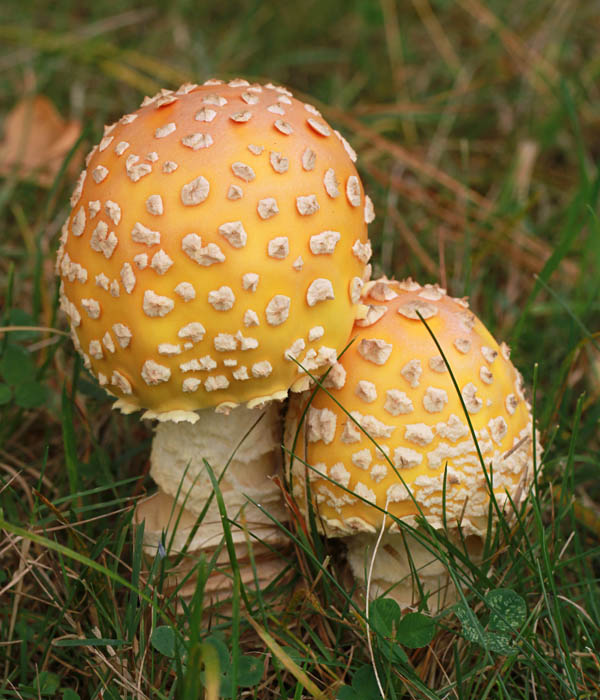Yellow Orange Fly Agarics Fruiting

The Yellow Orange Fly Agaric (Amanita muscaria var. formosa) is common in New England, especially where conifers grow. Out West this mushroom is often a bright red color, but in the East it’s typically orange/yellow.
When certain gilled mushrooms, including many Amanita species, first form they are encased in a membrane called a “universal veil.” As the mushroom enlarges and matures, the veil ruptures, with remnants of it remaining on the mushroom’s cap. Fly Agaric fungi got their name from the custom of placing little pieces of the mushroom in milk to attract flies. The flies supposedly become inebriated and crash into walls and die. This mushroom is somewhat poisonous (as are many Amanita species) and hallucinogenic when consumed by humans. The toxins affect the part of the brain that is responsible for fear, turning off the fear emotion. Vikings, who had a reputation for fierceness, are said to have ingested this mushroom prior to invading a village.
Naturally Curious is supported by donations. If you choose to contribute, you may go to http://www.naturallycuriouswithmaryholland.wordpress.com and click on the yellow “donate” button.
Yellow-orange Fly Agaric Mushroom
 The Yellow-orange Fly Agaric (Amanita muscaria var. formosa) is common in New England, especially where conifers grow. Out West this mushroom is often a bright red color, but in the East it’s typically orange/yellow. When certain gilled mushrooms, including many Amanita species, first form, they are encased in a membrane called a “universal veil.” As the mushroom enlarges and matures, the veil ruptures, with remnants of it remaining on the mushroom’s cap. Fly Agaric fungi got their name from the custom of placing little pieces of the mushroom in milk to attract flies. The flies supposedly become inebriated and crash into walls and die. This mushroom is somewhat poisonous (as are many Amanita species) and hallucinogenic when consumed by humans. The toxins affect the part of the brain that is responsible for fear, turning off the fear emotion. Vikings, who had a reputation for fierceness, are said to have ingested this mushroom prior to invading a village.
The Yellow-orange Fly Agaric (Amanita muscaria var. formosa) is common in New England, especially where conifers grow. Out West this mushroom is often a bright red color, but in the East it’s typically orange/yellow. When certain gilled mushrooms, including many Amanita species, first form, they are encased in a membrane called a “universal veil.” As the mushroom enlarges and matures, the veil ruptures, with remnants of it remaining on the mushroom’s cap. Fly Agaric fungi got their name from the custom of placing little pieces of the mushroom in milk to attract flies. The flies supposedly become inebriated and crash into walls and die. This mushroom is somewhat poisonous (as are many Amanita species) and hallucinogenic when consumed by humans. The toxins affect the part of the brain that is responsible for fear, turning off the fear emotion. Vikings, who had a reputation for fierceness, are said to have ingested this mushroom prior to invading a village.


















What Other Naturally Curious People Are Saying